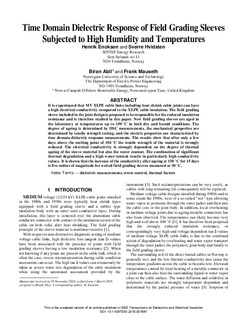| dc.contributor.author | Enoksen, Henrik | |
| dc.contributor.author | Hvidsten, Sverre | |
| dc.contributor.author | Abil, Biran | |
| dc.contributor.author | Mauseth, Frank | |
| dc.date.accessioned | 2019-08-16T09:04:57Z | |
| dc.date.available | 2019-08-16T09:04:57Z | |
| dc.date.created | 2019-08-15T07:39:10Z | |
| dc.date.issued | 2019 | |
| dc.identifier.citation | IEEE transactions on dielectrics and electrical insulation. 2019, 26 (4), 1220-1228. | nb_NO |
| dc.identifier.issn | 1070-9878 | |
| dc.identifier.uri | http://hdl.handle.net/11250/2608657 | |
| dc.description.abstract | It is experienced that MV XLPE cable links including heat shrink cable joints can have a high electrical conductivity compared to the XLPE cable insulation. The field grading sleeve included in the joint design is proposed to be responsible for the reduced insulation resistance and is therefore studied in this paper. New field grading sleeves are aged in the laboratory at temperatures up to 150 °C in both dry and humid conditions. The degree of ageing is determined by DSC measurements, the mechanical properties are determined by tensile strength testing, and the electric properties are characterized by time domain dielectric response measurements. The results show that after only a few days above the melting point of 104 °C the tensile strength of the material is strongly reduced. The electrical conductivity is strongly dependent on the degree of thermal ageing of the sleeve material but also the water content. The combination of significant thermal degradation and a high water content results in particularly high conductivity values. It is shown that the increase of the conductivity after ageing at 150 °C for 15 days is five orders of magnitude for wetted field grading sleeves measured at 30 °C. | nb_NO |
| dc.language.iso | eng | nb_NO |
| dc.publisher | Institute of Electrical and Electronics Engineers (IEEE) | nb_NO |
| dc.title | Time domain dielectric response of field grading sleeves subjected to high humidity and temperatures | nb_NO |
| dc.type | Journal article | nb_NO |
| dc.type | Peer reviewed | nb_NO |
| dc.description.version | acceptedVersion | nb_NO |
| dc.source.pagenumber | 1220-1228 | nb_NO |
| dc.source.volume | 26 | nb_NO |
| dc.source.journal | IEEE transactions on dielectrics and electrical insulation | nb_NO |
| dc.source.issue | 4 | nb_NO |
| dc.identifier.doi | 10.1109/TDEI.2019.007961 | |
| dc.identifier.cristin | 1716055 | |
| dc.description.localcode | © 2019 IEEE. Personal use of this material is permitted. Permission from IEEE must be obtained for all other uses, in any current or future media, including reprinting/republishing this material for advertising or promotional purposes, creating new collective works, for resale or redistribution to servers or lists, or reuse of any copyrighted component of this work in other works. | nb_NO |
| cristin.unitcode | 194,63,20,0 | |
| cristin.unitname | Institutt for elkraftteknikk | |
| cristin.ispublished | true | |
| cristin.fulltext | postprint | |
| cristin.qualitycode | 2 | |
